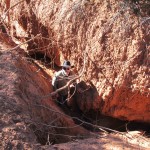
In mid-July of this year I ran across an article in the Washington Post that I found interesting, insightful, and positive enough for a mainstream media publication (in my opinion) that I composed a comment to submit in the “comments” box at the end of the article. That didn’t work, but my comment was accepted as a “letter to the editor,” for which I got an acceptance notification, but as far as I have been able to tell, the letter has never printed or published.
Because I found the article so interesting, insightful, and positive, however, and because I found a significant flaw in it — the mention of which I believed would add even more value to this out of the ordinary analysis (for a mainstream media publication) of what’s going on environmentally in the American West today — I decided to make my comment a post on rightwaytobegreen.com.
Here goes… The title, heading, and attribution of the article was (as shown in the header):
Once nearly extinct, bison are now climate heroes
Indigenous tribes are leading the effort to bring back the bison — a victory not only for the sake of biodiversity, but for the entire ecosystem they nurture
By Jess McHugh
July 13, 2022 at 12:25 p.m. EDT
Since my comment actually quotes much of what I find interesting and agreeable in the article I won’t include a lot of direct quotes, but if you would like to read the article in full, which I would recommend, use the title for a web search and take a look.
Here’s what I told the Washington Post about the article in my letter to the editor…
Much praise for your article identifying bison as climate heroes. Writer Jess McHugh is right on the money when he describes how bison “nurture their entire ecosystem — one that is increasingly under threat from climate change.” One problem I have with the article, however, is that it misses an important and expansive application of its own insights.
Starting with what I find so positive about the article, I want to praise its observations that “bison sustain their environment from the top down.” creating what “scientists have dubbed a “green wave”” when they “move synchronously across the land, producing a flood of new vegetation as their hoofs push seeds deep into the ground and aerate the soil, and that their dung — which contains high levels of nitrogen, a vital nutrient for plant growth — fertilizes the soil as they graze.”
I also want to praise the article for making it clear that Native Americans were part of this functional ecological interaction by quoting a member of the Sicangu Lakota (Rosebud Sioux) tribe who is executive director of the InterTribal Buffalo Council (a coalition working to restore the animal on tribal lands) saying, “Buffalo is the original climate regulator,” “They did this job for us when we allowed them to be buffalo.”
The problem I have with the article is it limits the influence (and value) of its insights when it differentiates between the effects of bison and cattle and insinuates that this difference cannot be remedied. Why this is a problem is that a movement is currently underway in the American west to manage cattle in much the same way Native Americans managed bison, elk and other hoofed ungulates. In other words, today (using quotes from the article) there are ranchers who use “holistic herd management techniques” and manage their cattle “like wildlife — not livestock”… in order “to maintain ecological balance and not to overgraze.”
Managed in these ways cattle produce some of the same effects as wild bison. As ranchers herd them synchronously across ranches that cover thousands of acres, their hooves actually do push seeds deep into the soil, aerating it and making it more receptive of moisture, as their dung fertilizes the mix. This creates the same “green wave” bison once did and, where they are returned, do again — a green wave that is incalculably valuable in the southern plains where periods of extreme drought and flooding (and massive wildfires) have cropped up more frequently in recent years and made the area especially vulnerable to climate change.
Fortunately, more and more ranchers are applying this climate-smart, holistic idea of a bison and Native American mimicking relationship with nature, creating more and more instances of the resurgence of local flora and fauna including native grasses, rare insects, and birds (and even native fishes). (Check this link: AMAZING ECOSYSTEM RESTORATIONS).
For this reason, recognizing, acknowledging, and reporting this growing awareness, in the case of ranchers and cattle as well as in the case of Native Americans and bison, is a victory, not only for the sake of biodiversity but for the entire ecosystem in which we all live and hope to continue doing so.





